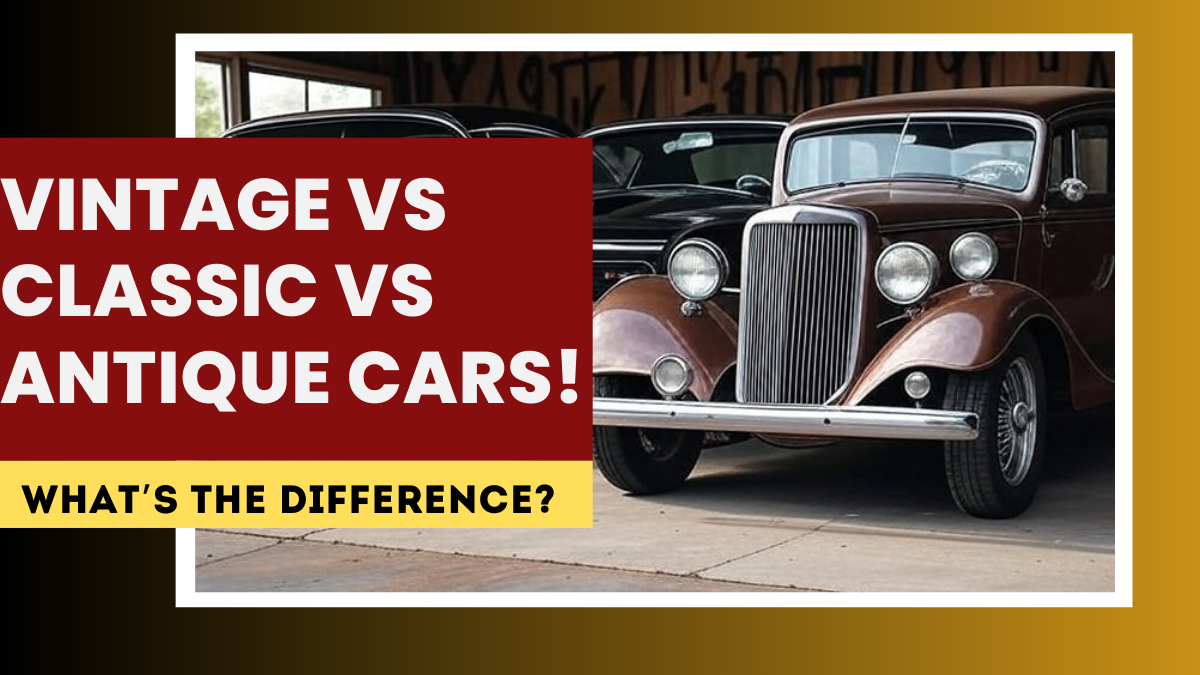For car enthusiasts, the terms vintage, classic, and antique cars are more than just labels; they represent specific eras, histories, and identities in the automotive world. Yet, many people casually interchange them without realizing that each has a unique meaning. Understanding these categories is essential for collectors, investors, restorers, and even insurance buyers, as classification affects everything from car club membership to registration laws.
This detailed car classification guide explores the distinctions between vintage, classic, and antique cars, supported by real examples, expert insights, and practical implications for owners.

What Defines a Vintage Car?
The term “vintage car” generally applies to vehicles produced between 1919 and 1930, the period following World War I and before the Great Depression. This was a transformative era when cars shifted from being experimental machines to reliable forms of transportation.
Notable Features of Vintage Cars:
-
Handcrafted designs with little automation in production.
-
Use of early mechanical technologies such as manual crank engines and non-synchronized gearboxes.
-
Elegant styling with long hoods, tall wheels, and open-top bodies.
-
Limited production numbers, making many extremely rare today.
Examples:
-
1925 Rolls-Royce Phantom I – known for luxury and smoothness.
-
1927 Ford Model T – the car that put America on wheels.
-
1930 Cadillac V16 – one of the most powerful cars of its time.
Vintage cars are primarily showcased in exhibitions, museums, or prestigious rallies. For investors, they hold unmatched historic value, but due to their age, they are often too delicate for daily driving.
What Defines a Classic Car?
Unlike vintage cars, the term “classic” is broader and less rigidly defined. Generally, a classic car is considered to be 20 to 40 years old, though exact definitions vary by clubs and insurance providers.
Notable Features of Classic Cars:
-
Represent designs and engineering milestones of their decades.
-
Usually mass-produced but now scarce due to attrition.
-
Easier to maintain and drive than vintage or antique cars.
-
Often associated with cultural moments, movies, or motorsports.
Examples:
-
1967 Ford Mustang – the icon of American pony cars.
-
1970 Chevrolet Chevelle SS – the epitome of raw muscle power.
-
1980 Porsche 911 – combining timeless design with precision handling.
Classic cars are especially popular among collectors because they balance nostalgia with practicality. Many are still driven at shows, parades, and even occasional leisure trips.
What Defines an Antique Car?
An antique car is typically defined as any vehicle 45 years or older. Unlike vintage, which applies to a specific era, antique is an age-based classification.
Notable Features of Antique Cars:
-
Can include both vintage and some early classics.
-
Qualify for antique registration plates and special insurance in many regions.
-
Generally preserved for display rather than frequent use.
Examples:
-
1910 Mercer Raceabout – an early performance car.
-
1931 Ford Model A – an affordable and historic model.
-
1950 Jaguar XK120 – among the fastest production cars of its time.
Antique cars are treasured as rolling pieces of history. Their ownership comes with responsibilities, as improper use can lead to rapid deterioration.
Why the Confusion Exists
The confusion between these terms stems from varying definitions across organizations and countries:
-
Insurance Companies often classify any car older than 25 years as “classic,” regardless of its rarity.
-
Car Clubs may have stricter standards, using specific cut-off years.
-
Government Regulations in some countries define vintage, classic, and antique differently for taxation and registration purposes.
For example, in the USA, the Antique Automobile Club of America (AACA) defines “antique” as 25 years or older, while in the UK, “vintage” is specifically 1919–1930. This inconsistency explains why terms are often mixed.
Key Differences at a Glance
Here’s a simplified table that highlights the difference between vintage, classic, and antique cars:
| Category | Age Range | Example Models | Typical Usage |
|---|---|---|---|
| Vintage | 1919 – 1930 | Rolls-Royce Phantom I, Ford T | Museums, High-end Rallies |
| Classic | 20 – 40 years old | Mustang, Chevelle, Porsche 911 | Collecting, Leisure Driving |
| Antique | 45+ years old | Mercer Raceabout, Jaguar XK120 | Preservation, Display |
This classification ensures clarity for buyers, sellers, and enthusiasts alike.
Why It Matters for Collectors and Owners
Understanding these historic vehicle terms isn’t just about semantics — it carries real-world consequences:
-
Insurance Premiums – Cars labeled as antique or vintage often qualify for reduced insurance rates due to limited use.
-
Registration Laws – Many regions offer special plates and tax exemptions for vintage or antique cars.
-
Resale Value – Collectors pay premiums for properly classified and documented cars.
-
Club Membership – Enthusiast clubs may restrict entry based on a car’s classification.
-
Authenticity Checks – Restorers and buyers rely on correct terminology to verify historical accuracy.
Final Thoughts
Owning or admiring an old car becomes much richer when you know exactly what you’re looking at. Vintage cars showcase the dawn of motoring, classics highlight cultural and engineering milestones, and antiques preserve automotive history in its purest form.
By understanding the difference between vintage, classic, and antique cars, enthusiasts can avoid confusion, invest wisely, and appreciate these vehicles for what they truly represent — timeless symbols of passion, progress, and pride on wheels.
FAQs
Is every vintage car also considered antique?
Yes, since antique covers all cars older than 45 years, vintage cars fall into that category too.
Can a modern car be called a classic?
Yes, cars that are at least 20 years old with cultural or historical value can be called classics, even from the 2000s.
Which category is most valuable for collectors?
Vintage cars are generally the rarest and most expensive, but certain classics like the Shelby GT500 can fetch equally high prices.
Do these definitions vary worldwide?
Yes, different countries and car clubs use slightly different timelines, which often causes confusion.
Click here to know more.
